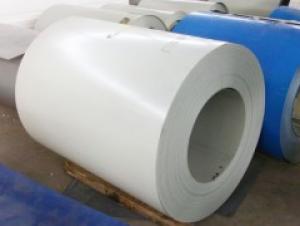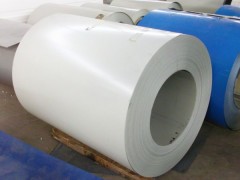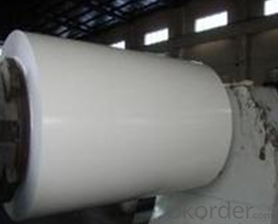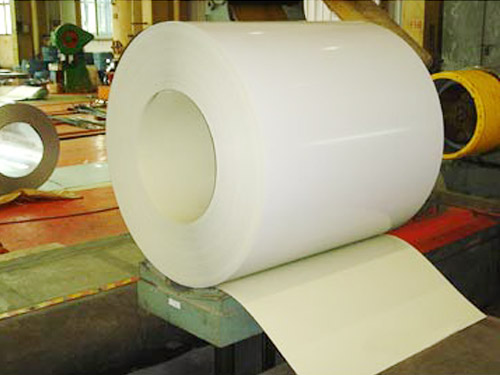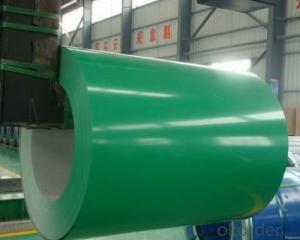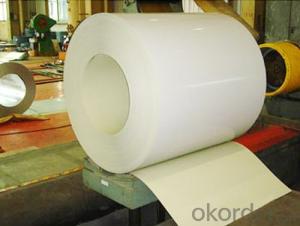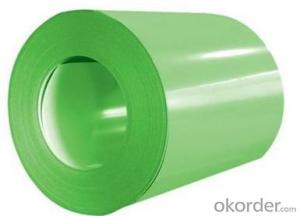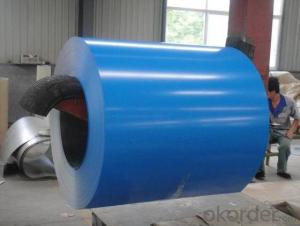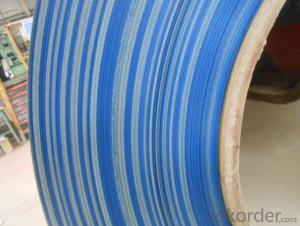Pre-Painted Galvanized Steel Coil in White
- Loading Port:
- Shanghai
- Payment Terms:
- TT OR LC
- Min Order Qty:
- 100 m.t.
- Supply Capability:
- 10000 m.t./month
OKorder Service Pledge
OKorder Financial Service
You Might Also Like
1. Pre-Painted Galvanized/Aluzinc Steel Coil Description:
With GI as base material, after pretreatment (degrease and chemical treatment ) and liquid dope with several layers of color, then after firing and cooling, finally the plate steel is called pre-painted galvanized (aluzinc) steel. Pre-painted galvanized steel is good capable of decoration, molding, corrosion resistance. It generally displays superior workability, durability and weather resistance.
2.Main Features of the Pre-Painted Galvanized/Aluzinc Steel Coil:
• Excellent process capability
• Smooth and flat surface
• Workability, durability
• Excellent heat resistance performance
• High strength
• Good formability
• Good visual effect
3.Pre-Painted Galvanized/Aluzinc Steel Coil Images
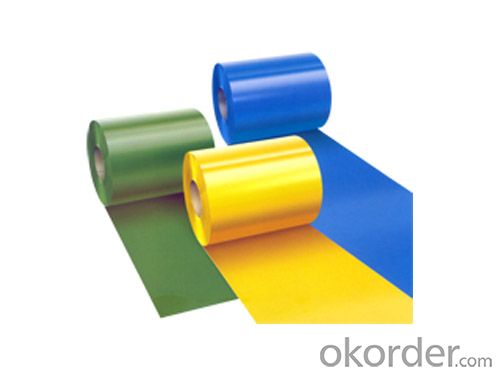
4.Pre-Painted Galvanized/Aluzinc Steel Coil Specification
Standard: AISI, ASTM, BS, DIN, GB, JIS
Grade: DX51D, DX52D
Thickness: 0.17-2.0mm
Brand Name: KMRLON
Model Number: coil
Type: Steel Coil
Technique: Cold Rolled
Surface Treatment: Coated
Application: Boiler Plate
Special Use: High-strength Steel Plate
Width: 20-1250mm
Length: customized
commoidty: pre-painted galvanized steel coil
Thickness: 0.13-4.0mm
width: 20-1250mm
zinc coating: 40-180g/m2
printing thickness: top side: 20+/-5 microns, back side: 5-7 microns
color: all RAL color
surface treatment: color coated
coil weight: 4-7 tons
coil ID: 508/610mm
packaging: standard seaworthy packing
5.FAQ of Pre-Painted Galvanized/Aluzinc Steel Coil
1. What’s the application of this product?
Roof, roof structure, surface sheet of balcony, frame of window, etc.
2. What’s the brand of the paint?
We use the best brand of all of the word—AKZO.
3. How to guarantee the quality of the products?
We have established the international advanced quality management system,every link from raw material to final product we have strict quality test;We resolutely put an end to unqualified products flowing into the market. At the same time, we will provide necessary follow-up service assurance.
4. How long can we receive the product after purchase?
Usually within thirty working days after receiving buyer’s advance payment or LC. We will arrange the factory manufacturing as soon as possible. The cargo readiness usually takes 15-25 days, but the shipment will depend on the vessel situation.
- Q: Can steel coils be used in the production of aerospace components?
- Yes, steel coils can be used in the production of aerospace components. Steel is a durable and versatile material that offers excellent strength-to-weight ratio, making it suitable for various applications in the aerospace industry. Steel coils can be processed and shaped to meet specific requirements, such as forming intricate components, structural parts, or even for use in aerospace engines. Additionally, steel's corrosion resistance properties and ability to withstand high temperatures make it a reliable choice for aerospace applications.
- Q: What are the common methods of cutting-to-length steel coils?
- Depending on the industry's specific requirements and capabilities, there are various common methods used to cut-to-length steel coils. 1. Shearing: For thinner gauge materials, one can utilize shearing, which involves using a shear blade to cut the steel coil into specific lengths. This cost-effective method is ideal for high-volume production. 2. Slitting: For narrower strips or multiple widths from a single coil, slitting is a suitable process. It entails passing the steel coil through rotating circular blades that cut the coil into desired widths. Slitting is commonly used for thinner gauge materials. 3. Laser cutting: To achieve precise and clean cuts, laser cutting employs a high-powered laser beam that melts and vaporizes the steel coil. This method is versatile, suitable for a wide range of materials, complex shapes, and contours. Laser cutting is often chosen for high-precision applications and smaller production runs. 4. Sawing: Thicker gauge materials are commonly cut using sawing. This method, which can be done manually or with automated sawing machines, involves using a saw blade to cut through the steel coil. Sawing is ideal for cutting large sections or heavy-duty applications. 5. Rotary cutting: Rotary cutting is frequently employed for thicker gauge materials in high-speed production. This method utilizes a rotary shear to cut the steel coil into desired lengths, providing a clean and accurate cut. Many industries prefer rotary cutting. It is important to consider that each method has its own advantages and limitations. The appropriate cutting method selection depends on factors such as material thickness, coil width, required precision, production volume, and budget constraints.
- Q: Steel sticks- it has meaning to us -similar to my deceased father's name, Steven fits our style as people. We like the hardness of it for our little man. We need a middle name though. Open to suggestions, thank you=)
- Steel Rod Tompkins Steel Blaze Tompkins Steel Adam Tompkins
- Q: How long do steel coils typically last?
- Steel coils typically last for decades. The lifespan of steel coils can vary based on several factors including the quality of the steel used, the level of maintenance and care, and the specific application they are utilized in. Generally, steel coils are designed to be durable and resistant to corrosion, ensuring a long lifespan. With proper care, regular maintenance, and adherence to recommended usage guidelines, steel coils can last anywhere from 20 to 50 years or even longer. However, it is important to note that the lifespan can be influenced by external factors such as exposure to harsh environments, extreme weather conditions, and the level of stress or load they are subjected to.
- Q: How are steel coils used in the production of construction materials?
- Steel coils are commonly used in the production of construction materials due to their strength, durability, and versatility. These coils are typically made from high-quality steel and are formed into a continuous, cylindrical shape. In the production of construction materials, steel coils are used in various ways. One primary application is in the manufacturing of steel beams, which are essential components in the construction of buildings, bridges, and other structures. Steel coils are processed and shaped into the desired size and dimension, allowing them to be easily formed into beams that can withstand heavy loads and provide structural support. Another important use of steel coils in construction materials is in the production of roofing materials. These coils are often transformed into corrugated sheets, which are widely used as roofing panels. The durability and weather resistance of steel make it an ideal choice for protecting buildings from the elements, including rain, snow, and strong winds. Additionally, these steel coils can be coated with protective layers to enhance their longevity and prevent corrosion. Steel coils are also employed in the production of construction materials such as pipes, tubes, and poles. These coils are formed into the desired shape and size, allowing for the creation of strong and reliable components for infrastructure projects. Whether it is for underground pipelines, structural support systems, or utility poles, steel coils provide the necessary strength and durability required for these construction materials. Furthermore, steel coils play a crucial role in the production of construction materials used in the fabrication of various fixtures and fittings. From door frames and window frames to reinforcement bars and wire mesh, steel coils are processed and shaped to meet specific requirements. This versatility allows for the creation of a wide range of construction materials that are essential for the completion of buildings and infrastructure projects. In conclusion, steel coils are extensively used in the production of construction materials due to their strength, durability, and versatility. From steel beams and roofing materials to pipes and fixtures, these coils are transformed into various shapes and sizes to meet the specific needs of construction projects. The use of steel coils ensures that construction materials are strong, reliable, and capable of withstanding the demands of the built environment.
- Q: How are steel coils used in the manufacturing of furniture?
- Steel coils are commonly used in the manufacturing of furniture as they provide structural support and stability. They are typically used in the construction of sofa frames, mattress foundations, and other furniture pieces that require strength and durability. The coils are often incorporated into the furniture's framework or used as a base for cushions and upholstery, ensuring long-lasting and comfortable products.
- Q: like, what can steel make?
- buildings bridges automobiles elevators railroads and railroad equipment appliances and many many more. Steel is used almost everywhere. reference: Iron and steel are used widely in the construction of roads, railways, infrastructure, and buildings. Most large modern structures, such as stadiums and skyscrapers, bridges, and airports, are supported by a steel skeleton. Even those with a concrete structure will employ steel for reinforcing. In addition to widespread use in major appliances and cars (Despite growth in usage of aluminium, it is still the main material for car bodies.), steel is used in a variety of other construction-related applications, such as bolts, nails, and screws.[66] Other common applications include shipbuilding, pipeline transport, mining, offshore construction, pipeline transport, aerospace, white goods (e.g. washing machines), heavy equipment (e.g. bulldozers), office furniture, steel wool, tools, and armour in the form of personal vests or vehicle armour (better known as rolled homogeneous armour in this role). .
- Q: Can steel coils be coated with electrically conductive materials?
- Yes, steel coils can be coated with electrically conductive materials. This coating process enhances the electrical conductivity of the steel coils and allows them to conduct electricity efficiently.
- Q: What are the common processing defects in steel coils?
- The common processing defects in steel coils include surface imperfections such as scratches, dents, and stains, as well as edge wave, coil set, camber, and crossbow. Other defects may include coil breaks, oil spots, rust, and uneven thickness or width variation.
- Q: I have a knife with 154cm steel on it and I always here that you should put oil on it to keep it from rusting but I am just wondering what kind of oil? And how do I apply it and do I just leave it on there?
- There are several grades of steel and other types of metals used in knives. Like another user said, if it is something like 420 Stainless Steel (a very common knife steel grade), then you should not have to worry about it rusting. I still apply oil to my stainless steel knives though to keep the action smooth. Non-stainless will require oil to prevent rust if you are planning on using them heavily. There is a such thing as knife oil and you can find it online. A lot of car or sportting lubricants will work though. I use Rem Oil, a popular gun oil that you can find at Wally World for about $3 a can. Disassemble your knife. Use a solvent and a cleaning solution to clean off the old oil, dirt, and gunk. I use Hoppes solvent (a solvent that can be found at Wal-Mart for a few bucks) and either pour it into a small shot-glass and dip a toothbrush in it, dampen a wash-rag with it, or pour some in the cap and dab a cotton swab on it. Using one of these tools, I swab down my knives completely, focusing mainly on moving parts and parts of the knife that experiences high abrasion (the lock of a liner lock knife for example). Then I spray it down with Rem Oil. Reassemble the knife and let it sit overnight. The next day, I'll rub off any excess oil from the grips. Usually though, the knife is ready to rock the moment I reassemble it. So that's cleaning knives in a nutshell: take it apart, clean off the old oil and dirt, re-oil it with gun oil, then put it back together.
Send your message to us
Pre-Painted Galvanized Steel Coil in White
- Loading Port:
- Shanghai
- Payment Terms:
- TT OR LC
- Min Order Qty:
- 100 m.t.
- Supply Capability:
- 10000 m.t./month
OKorder Service Pledge
OKorder Financial Service
Similar products
Hot products
Hot Searches
Related keywords
